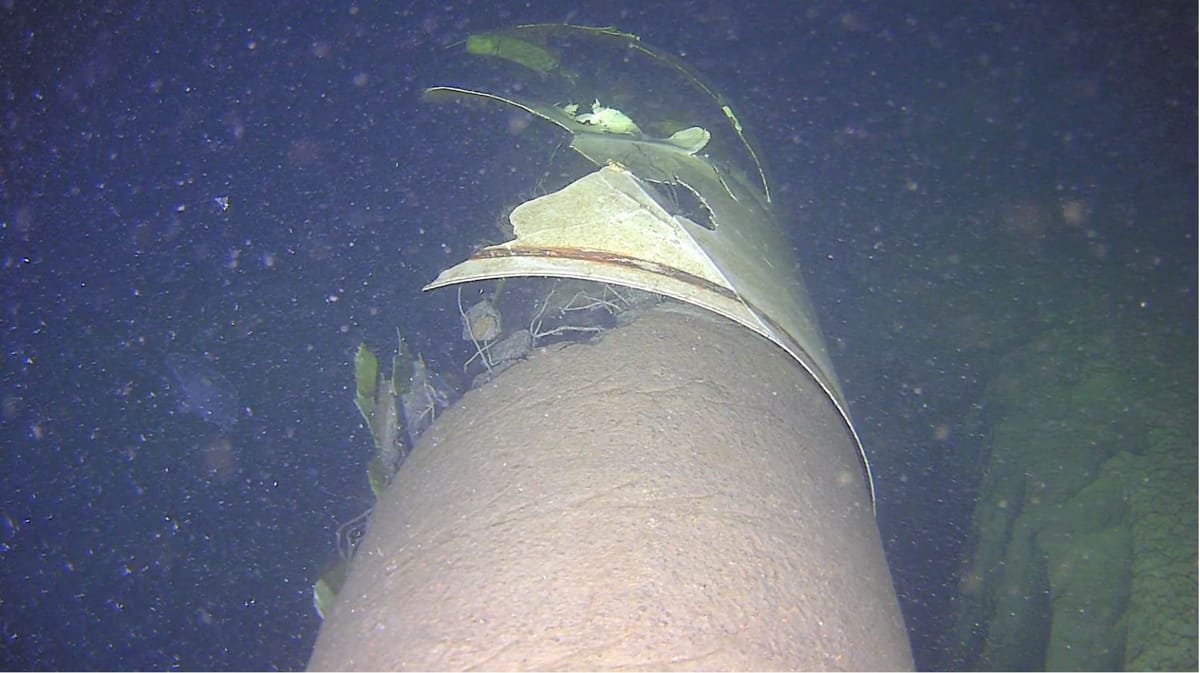China has finally acknowledged that the Hong Kong-flagged ship NewNew Polar Bear was responsible for damaging critical undersea infrastructure in the Baltic Sea. The incident – which Beijing is calling an “accident” – occurred in October 2023 and involved the Chinese ship damaging the 77 kilometre Balticconnector pipeline, an essential energy source for Finland along with an undersea data cable that connects Estonia to Sweden.
The acknowledgement emerged in reporting by the South China Morning Post this week, but it won’t put an end to suspicions about cable sabotage.
Estonian Defence Minister Hanno Pevkur suggested at the time that the damage to the pipeline and communications cable was likely deliberate. Finnish authorities, who recovered the anchor from the Chinese vessel that had dragged across the pipe and cable, deemed it a “deliberate external act” but were powerless to arrest the ship’s master after the vessel subsequently sailed to Russian ports and then into international waters.
China initially dismissed outright the European accusations that the NewNew Polar Bear was involved. But ten months later, according to the SCMP, Chinese authorities communicated their findings of an internal investigation via a Chinese-language report circulated among European ministries, blaming a strong storm.
China’s admission could be seen as an unusual display of transparency. But SCMP also notes that the report does not serve as official evidence in the ongoing criminal investigations in Estonia and Finland. China’s Ministry of Justice has yet to provide the requested legal assistance, leaving authorities in both countries sceptical about the extent of China’s cooperation.
Should a ship anchor drag across the seabed and slices through cables in international waters, there is no established mechanism to distinguish an accident from an act of sabotage.
This leaves critical questions about China’s genuine commitment to transparency and scrutiny. And the issue will continue to be raised, given concern for the security of undersea infrastructure extends far beyond Europe.
The potential for similar “accidents” in cable-dense regions such as Southeast Asia are illustrative of the fragility inherent in the global undersea data cable network. Consider the Straits of Malacca, arguably one of the world’s most critical cable chokepoints, where numerous undersea cables converge to power Southeast Asia’s digital economy. An incident there would reverberate throughout the region, potentially disrupting communications, internet connectivity and financial transactions. Recent experience during the Crowdstrike global outage could be significantly compounded.
The vulnerability of undersea cables was further demonstrated earlier this year by Houthi attacks on four connections in the Red Sea. This saw services disrupted from East Africa to Southeast Asia.
Australia’s links to global network also pass through a web of undersea cables, many of which crisscross through the South China Sea – a maritime arena defined by strategic significance and a formidable Chinese presence.

The NewNew Polar Bear incident should prompt a reassessment of the safeguards in place. The South China Sea, already a powder keg of territorial disputes and geopolitical tensions, faces the risk of undersea infrastructure being collateral damage – or being deliberately targeted. China’s expansive maritime claims in Southeast Asia and record of aggressive behaviour suggest that any disruption involving undersea cables here could escalate quickly and dangerously. This possibility underscores the need for Australia and its regional partners to urgently develop robust strategies to mitigate these risks, ensuring that any damage to undersea infrastructure is swiftly addressed.
What’s needed is a comprehensive Indo-Pacific regional cable protection framework, developed in collaboration with Southeast Asian and Pacific partners, to fortify undersea infrastructure against escalating geopolitical threats.
It also puts a spotlight on the broader challenge: How to investigate and attribute responsibility when undersea cables are damaged? Should a ship anchor drag across the seabed and slice through cables in international waters, there is presently no established mechanism to distinguish an accident from an act of sabotage. Australia, alongside regional partners, must push for stronger international frameworks that can differentiate between these scenarios and hold the responsible parties accountable.
For Australia’s part, the recent establishment of the Cable Connectivity and Resilience Centre with an $18 million investment over four years is a commendable start, framed as a contribution to efforts by the Quad grouping in this area. But alone this commitment will be insufficient.
What’s needed is a comprehensive Indo-Pacific regional cable protection framework, developed in collaboration with Southeast Asian and Pacific partners, to fortify undersea infrastructure against escalating geopolitical threats. This framework should include the establishment of cable protection zones across the Indo-Pacific and other measures to ensure the integrity of this critical infrastructure. The lack of a robust cable protection regime in Papua New Guinea or Solomon Islands, for instance, underscores the urgency.
The Baltic Sea incident should serve as a wake-up call, not just for Europe, but for Australia and its Indo-Pacific partners. The region’s heavy reliance on undersea cables, coupled with the strategic volatility of the South China Sea, should drive efforts address vulnerabilities in digital infrastructure protection frameworks. It is not only about preventing damage; it’s about ensuring that when damage occurs, it is addressed swiftly and precisely, with rigorous accountability enforced.

